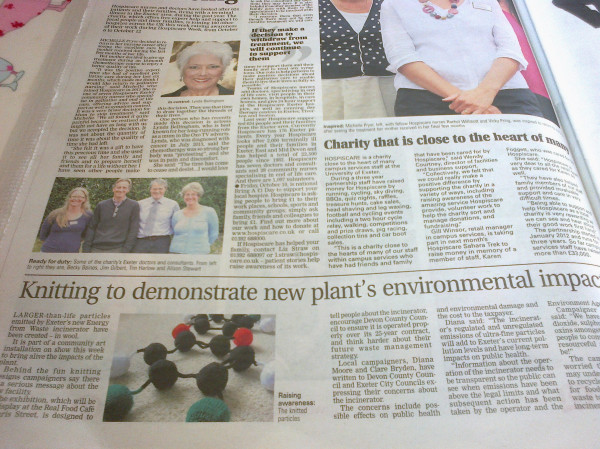Clare Bryden. When the world acted for the good. Church Times, 2 October 2015. Available on Church Times website (paywall).
THIS year is the 30th anniversary of the ozone “hole” and the Vienna Convention for the Protection of the Ozone Layer. The Convention and accompanying Montreal Protocol are among the most successful treaties of all time, in that they addressed a human-made environmental problem through rare but genuine international co-operation, and have almost completely achieved their goals.
Shortly after they were agreed, climate change arose as the next human-made problem on the agenda. The Vienna Convention became the model for the UN Framework Convention on Climate Change, but there are important differences, and climate negotiations are still without resolution.
The ozone layer is not really a layer, but a section of the stratosphere about 20-30km above the earth’s surface, where ozone concentrations are relatively high; and the ozone hole is not really a hole, but a reduction in concentration. In May 1985, reporting in Nature, the British Antarctic Survey (BAS) described losses of 70 per cent during the Antarctic spring, and four per cent globally.
Stratospheric ozone is important because it absorbs harmful UVB radiation from the sun, and protects us from sunburn, skin cancer, and cataracts. Stratospheric-ozone depletion is caused by emissions of chlorofluorocarbons (CFCs) and other man-made halocarbons, used in refrigeration, air-conditioning, and industrial solvents.
SCIENTISTS had been aware of ozone depletion since the mid-1970s, and five countries, including the United States, banned the use of CFCs in aerosol spray cans. Unsurprisingly, there was opposition from the CFC industry, using arguments that sound eerily familiar in a climate context: the theory was described as “a science fiction tale . . . utter nonsense”; and it was said: “We believe there is no imminent crisis that demands unilateral regulation.”
The governments of Germany, France, and the UK tried to defend their own industries, and progress in the US stalled during the first two years of President Reagan’s administration. But negotiations continued, and brought governments to the conference table in Vienna in March 1985. The Vienna Convention was a framework for further negotiations, and did not include legally binding reduction goals; so it was signed by 20 countries, including most of the main producers.
Then BAS announced the discovery of the Antarctic ozone “hole”, reviving public interest in the issue, and the US Environmental Protection Agency published a study predicting an additional 40 million cases of skin cancer and 800,000 cancer deaths in the US in the next 88 years. Then, possibly in fear of litigation, and having developed hydrochloroflurocarbons as a less destructive alternative to CFCs, US industry dropped its opposition to a CFC ban.
So, in 1987, 18 months after the Vienna Convention was signed, the world reached a binding agreement, and 43 nations signed the Montreal Protocol on Substances that Deplete the Ozone Layer.
THE UN Environment Programme said that the Montreal Protocol embodied three guiding principles. These later formed an important part of the 1992 Rio Declaration on Environment and Development, which sought to direct future sustainable development around the world.
First, the principle of common but differentiated responsibilities: the Protocol distinguished between two blocs of high and low CFC users. High users, who were largely responsible for the problem, were expected to act first. They agreed to reduce production of the five main ozone-depleting CFCs by 50 per cent by 1999. Low users, generally less-developed countries, had a ten-year grace period, and were provided with financial support.
Second, the precautionary principle: the risk of harm from inaction outweighed the risk of harm from taking action.
Third, the principle of basing policies and action on sound science: the Protocol was agreed before scientists had resolved all uncertainties and established a consensus, but the science was considered fit for purpose.
As the scientific evidence strengthened, so did the targets. In the 1990 London Amendment, signatories agreed to phase out CFCs almost entirely by 2000. In the 1992 Copenhagen Amendment, the phase-out date was moved up to 1996.
The Vienna Convention, Montreal Protocol, and its four Amendments are the only UN treaties to achieve ratification by all 193 member states. Many countries in both blocs met their phase-out targets well ahead of schedule. Tens of millions of skin cancers and cataracts have been avoided, and there have been substantial climate benefits.
THE Vienna Convention and Montreal Protocol were so successful that it seemed logical to follow the template when scientists first sounded the alarm about carbon emissions. Talks began in 1989 on what was to become the UN Framework Convention on Climate Change (UNFCCC).
There is, however, a big difference between convincing governments to ban chemicals manufactured by only a few countries and used in only a few applications, and persuading them to give up fossil fuels, when many rely on selling them for their national income, and almost all depend on burning them.
So the principle of common but differentiated responsibilities, and the precautionary principle, were subsumed by self-interest. And the stratospheric expectations for precision, confidence, and consensus have stretched the principle of basing policies and action on sound science almost to breaking point.
The UNFCCC was eventually agreed, and signed at Rio de Janeiro in 1992. But it left decisions about how this was to be accomplished to future negotiations, and, crucially, the rules on voting have never been agreed.
Although the 1997 Kyoto Protocol imposed targets on developed countries, only the EU took it seriously, and global carbon-dioxide emissions have soared. In December, world leaders are meeting in Paris for what is billed as “our last hope”. Let us hope and pray that the spirit of 1980s Vienna and Montreal prevails.








